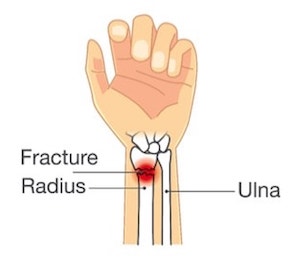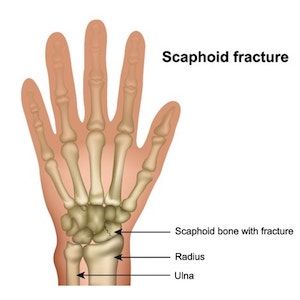Wrist Injuries and Wrist Fractures
 The wrist consists of 10 bones: 8 carpal bones, and 2 forearm bones, known as the radius and the ulna. Due to the sheer number of bones within the wrist, a wrist fracture can include a break in any one of the 8 carpal bones and distal ends of the radius and ulna. Wrist fractures, like distal radius fractures or scaphoid fractures, are very common, with approximately 1 out of every 10 fractured bone diagnoses being a wrist fracture. A fractured wrist is painful and can limit your ability to perform work and daily activities. It is important to seek medical attention as soon as possible if you believe you may have fractured your wrist. Without prompt treatment the bones may not heal in proper alignment, affecting your ability to perform daily tasks in the future.
The wrist consists of 10 bones: 8 carpal bones, and 2 forearm bones, known as the radius and the ulna. Due to the sheer number of bones within the wrist, a wrist fracture can include a break in any one of the 8 carpal bones and distal ends of the radius and ulna. Wrist fractures, like distal radius fractures or scaphoid fractures, are very common, with approximately 1 out of every 10 fractured bone diagnoses being a wrist fracture. A fractured wrist is painful and can limit your ability to perform work and daily activities. It is important to seek medical attention as soon as possible if you believe you may have fractured your wrist. Without prompt treatment the bones may not heal in proper alignment, affecting your ability to perform daily tasks in the future.
The most common cause of a fractured wrist are falls. Typically, a fracture occurs when falling onto an outstretched hand. However, many wrist fractures occur during contact sports and motor vehicle accidents as well. Wrist injuries may also occur as a result of work accidents.
What is a Wrist Fracture Settlement Worth?The settlement value of a wrist injury or wrist fracture case may be difficult to determine before reviewing medical evidence, such as medical records and bills, and having a clear understanding of the theory of liability. The value of wrist injuries can vary from case to case, depending on the type of wrist injury or fracture that occurred, the severity of injury, the treatment provided and the likelihood of permanency. Generally, damages for past and future pain and suffering, loss of a normal life, past and future medical bills, and wage loss can be obtained in a wrist injury settlement. However, a wrist injury settlement can be diminished based on whether a plaintiff’s own negligence (or “comparative fault”) contributed to the injury, or when there was a pre-existing medical condition that may also have contributed to the cause of the injury or the need for treatment.
Some of Our Firm’s Recent Wrist Injury SettlementsSlip and fall, negligence. Cook County, Illinois. Settlement for $175,000 was reached on behalf of a client who slipped and fell on a wet, laminate floor in the lobby area of a restaurant. As a result of the slip and fall, the victim suffered a distal radial metaphysis/epiphysis fracture, requiring two surgeries. The wrist injury settlement was obtained after mediation.
Balcony collapse, negligence. DuPage County, Illinois. Settlement for $120,000 was reached on behalf of a victim of a balcony collapse. The victim suffered a wrist fracture when a third floor apartment balcony suddenly collapsed. The collapse caused the victim and three others to fall to the ground, twenty feet below. The Naperville premises attorneys at John J. Malm & Associates worked with a structural engineer to show that the balcony had not been maintained properly.
Motor vehicle accident, negligence. Kane County, Illinois. Settlement for $100,000 was reached on behalf of a victim of a T-bone collision. As a result of the severe motor vehicle collision, the victim suffered a scaphoid wrist fracture, requiring surgical intervention. The wrist injury settlement was obtained with the at-fault party’s insurance carrier, State Farm Insurance Company.
What are the Symptoms of a Wrist Fracture?Symptoms of a wrist fracture vary depending on the severity and the type of fracture. However, signs and symptoms that can accompany a wrist fracture include:
- Pain that may worsen when gripping, squeezing, or moving your hand or wrist
- The wrist may appear deformed and hang in an odd or bent way
- Swelling
- Bruising
- Tenderness
- Tingling or numbness at the tips of the finger
Initially, your physician will perform a physical exam of the hand and wrist as part of the diagnostic process. However, an x-ray will be needed to confirm the diagnosis of a fractured wrist. Your physician may suggest other imaging tests as well, such as a computed tomography scan (CT scan) or magnetic resonance imaging (MRI), to produce more detailed images of the fracture and to identify any injuries to the ligaments, tendons, muscles, and nerves of the wrist.
What are the Types of Wrist Fractures? The wrist is composed of the distal ends of the radius and ulna, as well as the eight carpal bones, which include the scaphoid, lunate, triquetrum, pisiform, trapezium, trapezoid, capitate, and hamate. A fracture in any of these ten bones can be classified as a wrist fracture. There are many types of wrist fractures, however, the two most common types of wrist fractures include distal radius fractures and scaphoid fractures.
The wrist is composed of the distal ends of the radius and ulna, as well as the eight carpal bones, which include the scaphoid, lunate, triquetrum, pisiform, trapezium, trapezoid, capitate, and hamate. A fracture in any of these ten bones can be classified as a wrist fracture. There are many types of wrist fractures, however, the two most common types of wrist fractures include distal radius fractures and scaphoid fractures.
Distal radius fracture: The radius is one of the two bones in the forearm. A distal radius fracture occurs when the distal end or the end near the thumb-side of the wrist breaks. There are two variants of distal radius fractures that can be characterized by the angle of the distal radius as it breaks:
- Colle’s fractures occur when falling on an outstretched hand, where the hand is extended backward on the wrist. The distal radius shifts up towards the back of the hand causing a distinct bump in the wrist.
- Smith’s fractures occur during an impact to the back of the wrist, such as falling on a bent wrist, where the hand is flexed forward under the wrist. The distal radius shifts down towards the palm of the hand causing a distinct drop in the wrist.
 Scaphoid fracture: the scaphoid is one of the eight small carpal bones of the wrist. It is located at the base of the thumb just above the distal radius. As with distal radius fractures, a scaphoid fracture most commonly occurs due to a fall on an outstretched hand. A scaphoid fracture is accompanied by pain and swelling on the thumb-side of the wrist with worsening pain when pinching or gripping an object. Unlike a distal radius fracture, there is no deformity to the wrist when a scaphoid fracture occurs.
Scaphoid fracture: the scaphoid is one of the eight small carpal bones of the wrist. It is located at the base of the thumb just above the distal radius. As with distal radius fractures, a scaphoid fracture most commonly occurs due to a fall on an outstretched hand. A scaphoid fracture is accompanied by pain and swelling on the thumb-side of the wrist with worsening pain when pinching or gripping an object. Unlike a distal radius fracture, there is no deformity to the wrist when a scaphoid fracture occurs.
Treatment will depend on the bone fractured as well as the pattern of the fracture. Fracture patterns that can influence treatment include:
Non-displaced fracture: The fractured bone does not move and maintains proper alignment.
Displaced fracture: The fractured bone has broken into two or more pieces and has shifted out of alignment.
Intra-articular fracture: A fracture that extends into the wrist joint.
Extra-articular fracture: A fracture that does not extend into the wrist joint.
Open fracture: The fractured bone has broken through the skin.
Comminuted fracture: The bone breaks into more than two pieces.
Some wrist fractures may be treated using non-surgical methods, however, more complex fractures, such as an open fracture or a comminuted fracture, may require surgical intervention for proper healing.
Non-surgical treatment options: Non-surgical treatment options require immobilization of the bone for 4-6 weeks. If the fractured bone remains in anatomical alignment, then a splint or cast may be applied to achieve immobilization of the wrist. If the fracture causes the bone to become misaligned, then your physician must realign the fractured bone in a process called reduction, before a cast or splint can be applied.
Surgical treatment options: An open reduction (realignment of the fractured bone through surgical intervention) may be required in cases of more complex fractures where the bone is too misaligned or broken into multiple pieces preventing your physician from realigning the fractured bone in a closed reduction process. Once the fractured bone is realigned a cast or splint may be applied to immobilize the wrist and allow for proper healing. However, depending on the severity and type of fracture, further surgical intervention may be required to maintain bone alignment through a process called internal fixation. Once the fractured bone is realigned internal fixation devices such as metal pins, screws, metal plates, and stabilizing rods may be used to maintain proper alignment and stability during the healing process.
After the cast/splint or internal fixation devices are removed, most patients will require rehabilitation exercises and/or physical therapy to restore range of motion in the wrist.
Why is it Important to See an Orthopedic Surgeon if I Believe I Have a Wrist Fracture?Although some wrist fractures may resolve with home treatment, other fractures may require medical intervention, and may even require surgical intervention, to prevent further deformity to the wrist. During your visit, your orthopedic surgeon will examine your wrist fracture and order imaging to assess the extent of your injury. The orthopedic surgeon will then diagnose the type of wrist fracture and recommend appropriate treatment, including whether surgery may be necessary.
Contact the Naperville Personal Injury Lawyers at The Law Offices of John J. Malm & AssociatesThe knowledgeable attorneys at John J. Malm & Associates have successfully handled complicated cases for our clients who have suffered a wrist fracture. We are a team of experienced personal injury lawyers who represent individuals and families who have suffered an injury or loss due to an accident. You may be entitled to a substantial settlement if you have been injured. Call 630-527-4177, or 312-422-6855, and speak with Attorney John J. Malm and his team today.
 Naperville Accident Lawyers John J. Malm Home
Naperville Accident Lawyers John J. Malm Home



